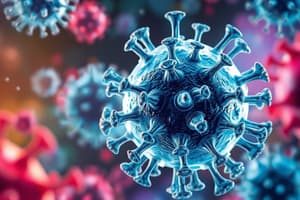Podcast
Questions and Answers
What is the study of fungi?
What is the study of fungi?
- Parasitology
- Mycology (correct)
- Virology
- Bacteriology
Which of the following is an example of a virus?
Which of the following is an example of a virus?
- Influenza (correct)
- Yeast
- Amoeba
- E. coli
What is the term for the study of microorganisms in their natural environments?
What is the term for the study of microorganisms in their natural environments?
- Immunology
- Microbial Ecology (correct)
- Mycology
- Parasitology
What is the term for the process by which microorganisms obtain energy from the environment?
What is the term for the process by which microorganisms obtain energy from the environment?
What type of relationship exists between two organisms in which one benefits and the other is not affected?
What type of relationship exists between two organisms in which one benefits and the other is not affected?
What is the application of microbiology in the diagnosis, treatment, and prevention of infectious diseases?
What is the application of microbiology in the diagnosis, treatment, and prevention of infectious diseases?
What is the term for a community of microorganisms that work together to perform specific functions?
What is the term for a community of microorganisms that work together to perform specific functions?
What is the phase of microbial growth where the cells are adapting to their environment and preparing for rapid growth?
What is the phase of microbial growth where the cells are adapting to their environment and preparing for rapid growth?
Flashcards are hidden until you start studying
Study Notes
Branches of Microbiology
- Bacteriology: study of bacteria
- Virology: study of viruses
- Mycology: study of fungi
- Parasitology: study of parasites
- Immunology: study of immune system and its interactions with microorganisms
- Microbial Ecology: study of microorganisms in their natural environments
Types of Microorganisms
- Bacteria: prokaryotic cells, typically 0.5-5.0 μm in size
- Examples: E. coli, Staphylococcus aureus
- Viruses: infectious particles, typically 20-400 nm in size
- Examples: Influenza, HIV
- Fungi: eukaryotic cells, typically 2-10 μm in size
- Examples: Yeast, Mold
- Protozoa: eukaryotic cells, typically 10-50 μm in size
- Examples: Amoeba, Giardia
- Algae: eukaryotic cells, typically 1-10 μm in size
- Examples: Green algae, Diatoms
Microbial Growth and Nutrition
- Nutrient sources: carbon, nitrogen, phosphorus, oxygen, and other essential elements
- Metabolic processes: photosynthesis, respiration, fermentation
- Growth factors: temperature, pH, moisture, oxygen availability
- Microbial growth curves: lag phase, log phase, stationary phase, death phase
Microbial Interactions and Relationships
- Symbiosis: mutualism, commensalism, parasitism
- Antagonism: competition, amensalism, predation
- Microbial communities: biofilms, consortia, soil microbiome
Microbiology Applications
- Medicine: diagnosis, treatment, and prevention of infectious diseases
- Food and Beverage: fermentation, spoilage, and preservation
- Environmental Science: bioremediation, biodegradation, and pollution control
- Agriculture: plant pathology, soil fertility, and pest control
Branches of Microbiology
- Bacteriology focuses on the study of bacteria
- Virology is the study of viruses
- Mycology explores the world of fungi
- Parasitology delves into the study of parasites
- Immunology examines the immune system and its interactions with microorganisms
- Microbial Ecology studies microorganisms in their natural environments
Types of Microorganisms
- Bacteria are prokaryotic cells, typically 0.5-5.0 μm in size, with examples including E. coli and Staphylococcus aureus
- Viruses are infectious particles, typically 20-400 nm in size, with examples including Influenza and HIV
- Fungi are eukaryotic cells, typically 2-10 μm in size, with examples including Yeast and Mold
- Protozoa are eukaryotic cells, typically 10-50 μm in size, with examples including Amoeba and Giardia
- Algae are eukaryotic cells, typically 1-10 μm in size, with examples including Green algae and Diatoms
Microbial Growth and Nutrition
- Microorganisms require carbon, nitrogen, phosphorus, oxygen, and other essential elements as nutrient sources
- Metabolic processes include photosynthesis, respiration, and fermentation
- Temperature, pH, moisture, and oxygen availability are growth factors that impact microbial growth
- Microbial growth curves consist of the lag phase, log phase, stationary phase, and death phase
Microbial Interactions and Relationships
- Symbiosis can take the form of mutualism, commensalism, or parasitism
- Antagonism can manifest as competition, amensalism, or predation
- Microbial communities can form biofilms, consortia, and soil microbiomes
Microbiology Applications
- Microbiology is crucial in medicine for diagnosis, treatment, and prevention of infectious diseases
- In the food and beverage industry, microbiology plays a role in fermentation, spoilage, and preservation
- Microbiology is essential in environmental science for bioremediation, biodegradation, and pollution control
- In agriculture, microbiology is important for plant pathology, soil fertility, and pest control
Studying That Suits You
Use AI to generate personalized quizzes and flashcards to suit your learning preferences.




